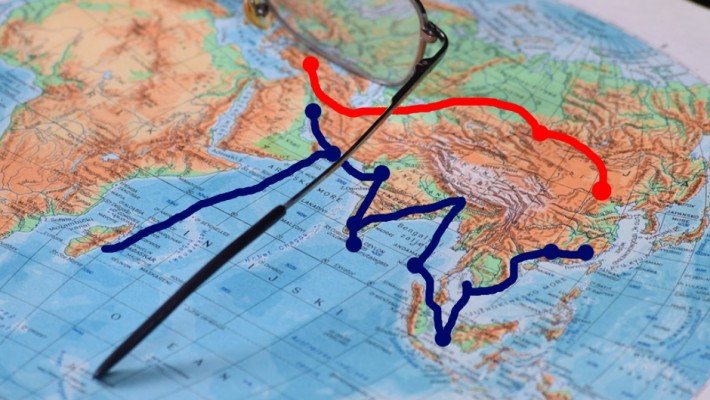Freight Forwarder Insights
Huin International Logistics Latest Articles
One Belt One Road– A Fresh Drive for Intermodal Transport in China
The pressure on policymakers in China to enhance the efficiency of freight transport has escalated due to a heavy reliance on imported fuels, significant concerns about transport-induced air pollution, and rising carbon dioxide emissions. This situation intensifies the urgency for effective solutions.
Presently, the trajectory of the freight sector appears unsustainable. From 2004 to 2014, the modal share of rail transport reduced by half, while road freight transport tripled. Currently, neither waterway nor rail transport can rival road transport in terms of speed, flexibility, accessibility, and reliability. The rail network predominantly transports bulk goods like steel and coal, with both infrastructure and operations tailored more towards moving large quantities rather than supporting containerized intermodal solutions. Consequently, the freight transport sector has matched the energy consumption levels of the road passenger sector, with 14 million trucks operating on Chinese roads, and one-third of these trips being empty runs. Intermodal logistic concepts, along with logistics alliances, remain relatively novel in China.
Logistics Terminology Overview:
Intermodal Transport: This is the movement of goods using the same loading unit or road vehicle across multiple modes of transport without directly handling the goods during transfers (Source: UNECE Terminology on Combined Transport).
Freight Villages: These are clusters of transport-oriented companies, logistics service providers, and logistics-intensive trade and production enterprises within a commercial area. Typically, they feature an intermodal terminal accessible to users and leverage the synergies across various sectors.
Intermodal freight transport has gained prominence in national policymaking. Policies and measures have been introduced in recent years, including the "Belt and Road Initiative," which is more than just a road link between Europe and China. This initiative includes substantial financing for expanding intermodal rail infrastructure aimed at shifting more freight transport from road to rail.
Domestically, the Chinese government has embarked on several initiatives to boost rail freight transport's competitiveness. The national logistic plan includes expanding a nationwide network of container terminals and freight villages. The Deutsche Gesellschaft für Internationale Zusammenarbeit (GIZ) GmbH, on behalf of the German Federal Ministry for Environment, Nature Conservation, Building, and Nuclear Safety (BMUB), is assisting the Chinese Ministry of Transport in developing technical guidelines to effectively steer this process.
Intermodality Necessitates Collaboration
Enhancing intermodality requires the concerted efforts of policymakers, the private sector, and academia. Reflecting this need, GIZ and the Transport Planning and Research Institute (TPRI) of the Chinese Ministry of Transport hosted the "Sino-German Intermodal Transport Forum" on June 27-28, 2016, in Beijing. The forum saw overwhelming interest from Chinese experts, with more registrations than the venue's 150-seat capacity could handle.
The urgency for rapid results spurred dynamic debates among freight forwarders, rail operators, administrators, and planning authorities during the two-day workshop. German experiences with freight villages, inland ports, and intermodal cargo technologies captured significant interest.
Clemens Bochynek, CEO of the German Association for Intermodal Transport, discussed container types and handling systems used in Germany, noting that only ISO standard containers are currently used on the Chinese rail network.
Ralf Charley Schulze, President of the International Union for Road-Rail Combined Transport (UIRR), provided insights into market conditions and policy frameworks from intermodal operators' perspectives. The deregulation of the railway sector during the 1995 railway reform garnered substantial attention. Lars Nennhaus, Vice President of Port Development at Duisport, explained key operational features of the world's largest inland port, which now serves as a significant destination for the EU-China rail connection. The Chengdu intermodal logistics park has also established itself as a crucial hub linking various destinations within China. The park is part of early initiatives under the Master Plan by the German Association for Freight Villages (DGG). CEO Steffen Nestler shared current development trends and the involvement of German freight villages such as Nürnberg, Herne, and Frankfurt (Oder) in the Chinese market. Discussions focused on the responsibilities of public stakeholders in the planning stages and conditions for soft loans and subsidies for constructing transshipment terminals for combined transport.
Prominent German logistics companies like DHL and BLG Logistics Group shared insights on their intermodal transport engagements, introducing best practices and intermodal logistics solutions. CargoBeamer showcased innovative technologies for handling non-cranable semi-trailers.
Dong Wanxu, General Manager China of Trans-Eurasia Logistics GmbH (TEL), a joint venture between Deutsche Bahn and RZhD, provided perspectives on competing in international trade with prevalent maritime transport. Land connections, while shorter than sea routes, remain a focal point for discussion among German and Chinese transport experts. The Chinese government's substantial investments in intermodal rail infrastructure and subsidies for the operation of China-EU block trains present a critical window of opportunity. However, achieving full utilization of two-way traffic remains a significant challenge, with satisfactory cargo loads to Europe but insufficient return traffic. Notable progress in sectors like automotive components and chemicals indicate a promising trend. Currently, 39 intermodal rail connections operate between Europe and China, though service frequency and consistency lag compared to established sea routes.
To address these challenges effectively, GIZ has initiated an international expert panel on intermodal transport, supported by the Sino-German Cooperation on Low Carbon Transport under the BMUB's international climate protection initiative.
